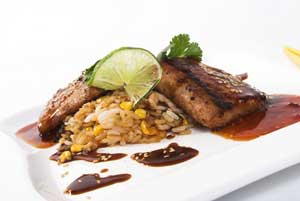Mahi Mahi
 |
Mahi-mahi is a beautiful game fish that is treasured for its firm, flaky flesh.
|
History
Mahi-mahi means “strong strong” in Hawaiian, but the fish was originally known as “dolphin-fish” and is still a source of confusion on menus in some regions. Because of the public’s hesitancy to consume dolphin (the mammal) - which is unrelated - the newer name has generally been adopted in most parts of the world.
Buying Tips
It is typically sold as steaks or fillets. These will be firm with a “spring” to the flesh; moist, but with no residual liquids in the package. Fillets will have visible rows of red blood spots or “lines.” Meat is pink when fresh, but will become opaque-white when properly cooked.
For any preparation other than grilling, request that the skin be removed before buying.
Storage Tips
Rinse well and dry with paper towels. Keep elevated on a rack over ice with a top layer of plastic to prevent drying out. Refrigerate no more than two days. Mahi-mahi freezes well for up to four months, but ideally should be double-wrapped in freezer paper.
Usage Tips
• Always begin grilling with the skin side down. This will help keep the flesh from breaking apart. The skin is tough, however, and should be removed before serving.
• This is a bold-tasting fish that can stand up to heavy seasoning and flavorful sauces.
• Baste often or cook in liquids. Mahi-mahi is a low-fat fish and can dry out quickly.
Substitution Tips
Swordfish, striped bass, mackerel
Try one of our favorite mahi-mahi recipes:
Mahi Mahi Burgers
Lime And Cumin Mahi Mahi
Mahi Mahi Ceviche





